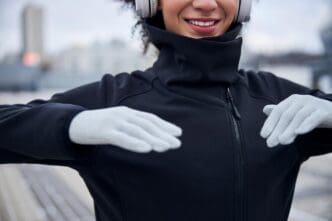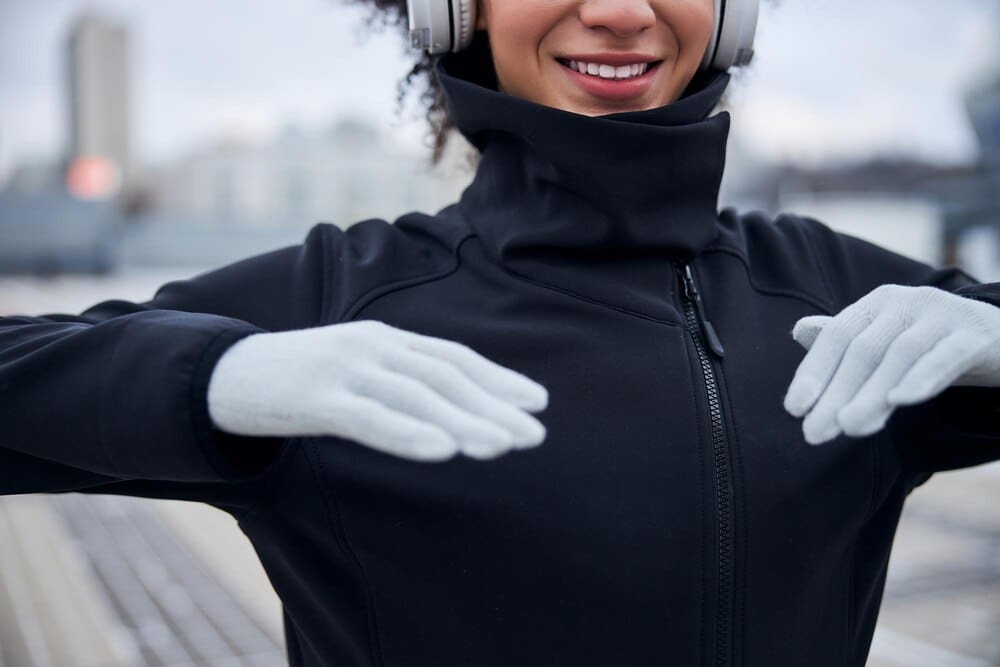For runners of all abilities, selecting the right pair of gloves or mittens is a critical component of a successful winter running strategy, transforming a potentially miserable experience into a comfortable and safe one. This decision goes far beyond simple comfort; it is a matter of physiological necessity. When running in the cold, the body prioritizes blood flow to the core to protect vital organs, leaving extremities like the hands vulnerable to biting winds and frigid temperatures. The right handwear provides essential insulation, prevents dangerous conditions like frostnip, and ultimately allows you to focus on your performance and enjoy your run, no matter how low the mercury drops.
Why Your Hands Get So Cold When You Run
Understanding why your hands feel like ice blocks on a winter run begins with a basic lesson in human physiology. Your body is a highly efficient machine designed for survival, and its primary directive in cold weather is to maintain its core temperature.
To achieve this, it initiates a process called peripheral vasoconstriction. This is a complex term for a simple action: the blood vessels in your extremities—your hands, feet, ears, and nose—narrow significantly. This narrowing reduces blood flow to these areas, redirecting that warm blood back toward your torso to keep your heart, lungs, and other organs functioning optimally.
While this is a brilliant survival mechanism, it leaves your hands with a dramatically reduced supply of heat. This effect is compounded by the fact that hands have a high surface-area-to-volume ratio, meaning they lose heat to the surrounding environment much faster than other parts of your body.
Add in factors like wind chill, which accelerates heat loss, and any moisture from sweat, and you have a perfect recipe for painfully cold fingers. For some individuals, particularly those with conditions like Raynaud’s phenomenon, this physiological response is even more exaggerated, causing fingers to become numb, white, and painful with even minor exposure to cold.
Gloves vs. Mittens: Which Is Right for You?
The choice between gloves and mittens is the first major decision you’ll make, and it hinges on a trade-off between warmth and dexterity. There is no single “best” answer; the right choice depends on the temperature, your personal physiology, and your on-the-run needs.
Running Gloves
Gloves encase each finger individually. This design provides the highest level of dexterity, allowing you to easily operate a GPS watch, unzip a pocket, open a gel packet, or use your smartphone without having to expose your skin to the cold.
The primary drawback of this design is reduced thermal efficiency. Because your fingers are separated, they cannot share warmth. Each finger must generate and retain its own heat, making gloves a less effective option in truly frigid conditions.
Best for: Milder winter days (e.g., above 30°F / -1°C), runners who prioritize dexterity for interacting with gear, and those who don’t suffer from exceptionally poor circulation.
Running Mittens
Mittens group your four fingers together in a single compartment, with a separate space for the thumb. This simple design change makes a massive difference in warmth. By keeping your fingers together, they can share radiant heat, creating a much warmer microenvironment inside the mitten.
This superior warmth comes at the cost of dexterity. Simple tasks become more challenging, and using a touchscreen is often impossible. However, for sheer protection against the cold, mittens are the undisputed champion.
Best for: Very cold temperatures, long runs in harsh weather, and runners who have Raynaud’s or naturally cold hands.
Convertible and Hybrid Options
Recognizing the core dilemma, many brands now offer hybrid designs, often called convertible mittens. These typically feature a standard glove with a stowable, lightweight mitten “hood” that can be pulled over the fingers when extra warmth is needed.
This gives you the best of both worlds: the dexterity of a glove for milder parts of your run or for tasks, and the added insulation of a mitten when the wind picks up or the temperature drops. Another variation is the “lobster” or “three-finger” mitten, which groups the pinky and ring finger together and the middle and index finger together, offering a compromise between the warmth of a mitten and the dexterity of a glove.
Key Features to Look for in Winter Running Gloves and Mittens
Beyond the basic style, the specific features and materials of your handwear will determine its performance. A well-designed pair of running gloves is a piece of technical apparel, just like your jacket or tights.
Material and Insulation
The fabrics used are the foundation of warmth and comfort. Look for technical materials designed for athletic use. Common options include synthetic fabrics like polyester and nylon, which are durable and excel at wicking moisture away from your skin.
Merino wool is another exceptional choice. This natural fiber is renowned for its ability to insulate effectively even when it gets damp from sweat. It’s also soft against the skin and naturally odor-resistant, which is a significant bonus for gear you’ll use repeatedly.
Fleece is often used as a lining material for its softness and warmth, but ensure it’s part of a system that also wicks moisture, as basic fleece can become saturated and cold when wet.
Weather Resistance
Protecting your hands from the elements is paramount. A windproof barrier is arguably the most important feature for running. A cold wind can strip heat from your hands instantly, a process known as convective heat loss. Look for products that incorporate a wind-blocking membrane, such as GORE-TEX INFINIUM™ or a similar proprietary technology.
You also need to consider moisture. For most winter running, which involves snow or light precipitation, a water-resistant finish is sufficient. This is typically achieved with a Durable Water Repellent (DWR) coating that causes water to bead up and roll off. Fully waterproof gloves are often less breathable and can be overkill unless you consistently run in heavy, cold rain.
Breathability and Moisture Wicking
This might seem counterintuitive for a piece of gear meant to keep you warm, but breathability is non-negotiable. As you run, your hands will sweat, even in the cold. If that sweat vapor is trapped inside your glove, the fabric will become damp, and wet fabric rapidly loses its insulating properties.
Sweaty hands quickly become cold hands. A good running glove must be breathable, allowing this moisture vapor to escape while still blocking external wind and cold. This moisture-wicking capability is what keeps your hands dry from the inside out, which is essential for staying warm.
Fit and Dexterity
The fit should be snug but not constricting. A glove that is too tight can actually impair circulation, making your hands colder. Conversely, a glove that is too loose will have air gaps that reduce insulation and will feel clumsy.
Look for features like pre-curved fingers that mimic the natural shape of your hand at rest, as well as stretch panels that allow for a full range of motion without feeling restrictive.
Extra Features
Modern running gloves often come with thoughtful details that enhance their utility. Touchscreen-compatible fingertips are now a near-standard feature, allowing you to use your phone or watch without exposure.
Reflective details are crucial for safety, increasing your visibility to drivers and cyclists during the low-light conditions common in winter. A soft patch of fabric on the thumb, often called a nose wipe, is a surprisingly practical feature for managing the inevitable runny nose that comes with cold-weather exercise. Some models even include small pockets for a key or a disposable hand warmer for an extra boost on the coldest days.
How to Layer Your Handwear for Extreme Cold
For expeditions into truly arctic conditions, or for those who are extremely sensitive to cold, applying the principles of layering to your hands is the ultimate solution. Just as you layer your torso with a base layer, mid-layer, and shell, you can do the same for your hands.
Start with a thin, snug-fitting liner glove made from a moisture-wicking material like lightweight merino wool or silk. This base layer’s sole job is to pull sweat away from your skin.
Over the liner, wear your primary insulated glove or mitten. For maximum protection, this outer layer would be a windproof and water-resistant shell mitten. This system traps a layer of air between the liner and the shell, creating exceptional insulation. It also gives you the versatility to remove the outer mitten if you start to overheat, without having to fully expose your hands.
Caring for Your Running Gloves and Mittens
To ensure your investment lasts for many seasons, proper care is essential. Always check the manufacturer’s care label first. In general, it’s best to wash technical gloves and mittens in cold water on a gentle cycle, using a mild detergent.
Avoid fabric softeners, as they can clog the pores of technical fabrics and inhibit their moisture-wicking and breathable properties. Most importantly, always air dry your handwear. The high heat of a machine dryer can damage or shrink the materials, degrade the elastic, and destroy any waterproof membranes or DWR coatings.
Investing in a quality pair of running gloves or mittens is not an indulgence; it’s a fundamental piece of equipment for anyone serious about running through the winter. By considering the conditions you’ll face and understanding the key features that provide warmth, weather protection, and comfort, you can eliminate one of the biggest barriers to cold-weather training. The right handwear empowers you to embrace the season, ensuring your focus remains on the rhythm of your feet and the crisp winter air, not on your painfully cold fingers.







